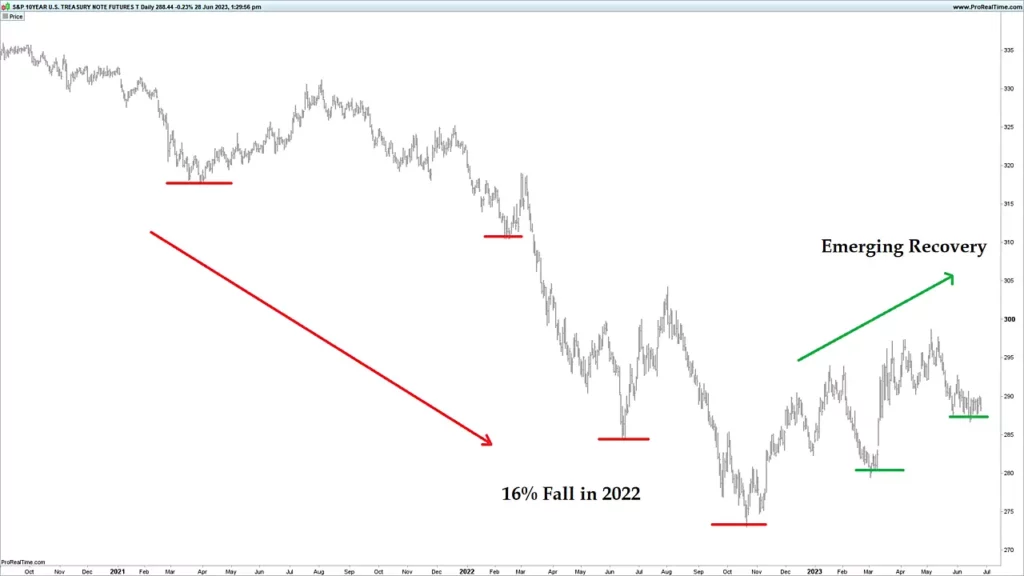It’s been a tough few weeks for the gold bulls.
It was only two months ago they were screaming from the roof calling for a gold ‘break-out’ into all new highs.
That was on the back of a strong recovery from 2022’s lows. It was also thanks to several major economies across Asia buying up big on gold bullion to boost their reserves.
That’s been the catch-cry for the gold bulls in 2023 — nations in the east buying gold as a possible move away from the U.S. dollar in international trade. Yet despite the buying spree, gold futures continue to weaken.
Why?
Interest rates.
With central bankers across Europe, Australia, and the U.S. all doubling down on their commitments to raise rates for longer and stronger, pressure is mounting on the gold sector. So too, are the hopes and dreams of gold investors.
While gold futures have shed a modest 8% from their May top, many of the miners have worn heavy losses as central bankers dial up their hawkish rhetoric.
The emerging African-based producers Tietto Minerals (ASX: TIE), Perseus Mining (ASX: PRU) and West African Resources (ASX: WAF) have shed 35%, 34% and 20%, respectively, since the price of gold made its top just two months ago.
But are gold investors giving too much weight to central bankers in this recent sell-off?
From what I can tell this is central banker bluff misleading the market into a false sense of pessimism to dampen expectations.
It wouldn’t be the first time gold stocks have misjudged market conditions. With an end-date in sight, gold stocks turned bullish earlier this year as central bankers proposed mid-2023 as the finish line for raising rates. Futures soared more than US$300 per oz. of gold in just six months.
Yet the bullish outlook was quickly deflated and all it took was an extension to the rate-hiking agenda.
That meant the mid-2023 finish line was taken away from the gold bulls. Investors liquidated their positions.
So, with central bankers dialling up the hawkish commentary once again, gold stocks are being priced accordingly.
But listening to the U.S. Fed (or any other central banker) is a fool’s game.
The smart money knows this — which is why you should be watching it.
Long-term bonds continue to signal rate cuts
It’s said that the smart money follows debt while the dumb money follows equities.
Bonds are a much larger market and consist of professional investors, fund managers and investment bankers. Equity investors, on the other hand, tend to be more emotive and include less sophisticated, mom and pop dabblers who invest based on last night’s news headlines.
Of course, that’s a very general view. Stocks are made up of insiders and sophisticated investors, too. But the influence of social media is certainly driving the equity market into a new ‘emotive’ era, buying and selling based on the latest Twitter feed.
It’s why the debt market is critical for understanding the future trajectory of the economy, especially when it comes to the direction of interest rates. So, if we take these observations as truth, what is the smart money telling us?
Well, the S&P 10-year treasury futures continue to indicate lower rates, despite the latest central bank comments.
Why does that matter?
Simply put, when interest rates are expected to fall, bond prices rise. Ten-year treasuries continue to recover on the back of last year’s nose dive.

10-year U.S. Treasuries. Source: ProRealTime
Given that long-term treasuries are continuing to trend up suggests the smart money is firmly backing interest rate cuts.
Or in other words, money managers are doing exactly the opposite of what the Fed would have them believe… that further rate hikes are on the way.
Some observers believe this represents a mispricing in the debt market or that they are simply failing to heed the warning from the Fed. However, the bond market is far smarter than the U.S. Fed or any other central banker. Which is why gold investors should be paying attention to this important metric.
Ten-year treasuries have been rising since October 2022. The upward momentum continues despite aggressive rate hiking rhetoric. The exact reason that’s leading the smart money into long term bonds is less clear.
An inevitable recession as higher rates place pressure on businesses, further banking crisis or a black-swan geopolitical event in the making, we don’t know. The real reason will come to light soon, I’m sure.
Importantly though, the bond market continues to signal lower rates ahead. That’s the only thing that should matter for gold investors in this current environment.
But even if you’re not a gold bull, this sector is presenting a juicy opportunity for investors. With gold speculators out of the market, right now is perhaps an ideal time to begin accumulating gold stocks for your portfolio.
— This column was previously published in Livewiremarkets.com.
James Cooper is a former exploration geologist turned mining analyst. He’s worked for major and junior companies throughout Australia and Africa, including Barrick Gold, Equinox Minerals, Crosslands Resources, and Northern Star and has been involved with all phases of exploration across a host of different commodities. Based in Melbourne, he’s now the resident commodities analyst at Fat Tail Investment Research and editor for the Diggers & Drillers Publication.





Be the first to comment on "Is it time to buy deflated gold stocks?"